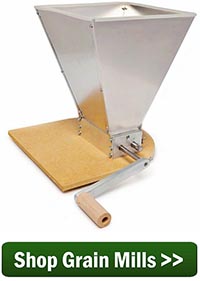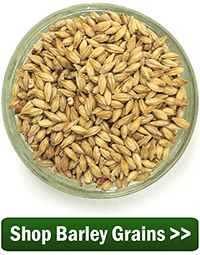 Dogfish Head’s popular 60-, 90-, and 120-Minute IPAs came into being through a pretty innovative hopping technique. Instead of adding hops at intervals, the hops are adding continuously through the boil. Early on, Dogfish used a modified foosball table to shake the hops into the brew kettle. They’ve come a long way since then, but their IPAs are still delicious as ever.
Dogfish Head’s popular 60-, 90-, and 120-Minute IPAs came into being through a pretty innovative hopping technique. Instead of adding hops at intervals, the hops are adding continuously through the boil. Early on, Dogfish used a modified foosball table to shake the hops into the brew kettle. They’ve come a long way since then, but their IPAs are still delicious as ever.
Grain Bill
The grain bill for this Dogfish Head 90-Minute IPA clone recipe is surprisingly simple: 90% pilsner malt with 10% amber malt. If you haven’t heard of amber malt before, it’s a specialty malt somewhere between a caramel 20L and a caramel 40L, featuring flavors of biscuits and toast and contributing a – you guessed it – amber color to your homebrew. It’s traditionally used in English ales, up to 20% of the grist.
Hopping 
90-Minute IPA uses Amarillo, Simcoe, and Warrior hops, sprinked into the wort gradually over the course 90 minutes. Just in case you don’t have a foosball table, an easy way to do it mix the hops together and then divide them into equal parts to add every 5-10 minutes. For example, if you wanted to add the hops every 5 minutes, divide the three or so ounces of hops into 19 equal parts. This will give you a roughly 4.7 gram hop addition every five minutes, including one at flame out.
For additional hoppy aroma, the same hops used in the boil are used for dry hopping.
Ready to give this Dogfish Head clone recipe a try? It comes from Brew Your Own Magazine (with the help of Sam Calagione himself!).
Dogfish Head 90 Minute IPA Clone Recipe
(5-gallon batch, all-grain recipe)
Specs
OG: 1.088
FG: 1.021
ABV: 8.7%
IBUs: 90
SRM: 13
Ingredients
16.5 lbs. pilsner malt
1.66 lbs. amber malt
2 oz. Amarillo hops (16 AAUs) added over 90 minutes
0.62 oz. Simcoe hops (8 AAUs) added over 90 minutes
0.53 oz. Warrior hops (8 AAUs) added over 90 minutes
1 oz. Amarillo hops (dry hopped 3-5 days)
0.5 oz. Simcoe hops (dry hopped 3-5 days)
0.5 oz. Warrior hops (dry hopped 3-5 days)
1.5 packets Safale S-04
Directions
Mash the crushed grains in about five gallons of clean water at 122˚F, then raise for 149˚F for 60 minutes. Sparge to collect about 7.5 gallons of wort. Boil for 105 minutes, adding the hops after 15 minutes gradually over the rest of the boil. Whirlpool, chill wort, and transfer to a clean, sanitized fermenter. Pitch yeast at 70˚F or below. Ferment at 71˚F. After primary fermentation, transfer to a secondary fermenter and dry hop for 3-5 days. Cold crash, then bottle or keg for ~2.3 vols CO2.
If you like IPA’s but haven’t ever tried a clone recipe before, this would be a fun one for you. The Dogfish Head 90 IPA is an incredible beer. It has a lot of malt flavors and body to support the extreme hopping. It’s aggressive, but balanced.
—–
David Ackley is a beer writer, brewer, and self-described “craft beer crusader.” He holds a General Certificate in Brewing from the Institute of Brewing and Distilling and is founder and editor of the Local Beer Blog.

I made a Strong Black Cherry Stout over three years ago, and the first year it was, to me, undrinkable. I never toss anything out until I give it the benefit of time, however, and by year 3 it was “whoa, this is pretty good.” We had a recent popular vote homebrew contest at a local beeerfest. I brought about 7-8 brews, 3 that I entered in the contest, one of which took second place. Yet I was scolded by the public that was doing the tasting, because the by then 4 year old Strong Cherry Stout was getting all the attention, and I had not entered it into the contest. I have aged many barleywines and doppelbocks over 3 years, some of which have placed in various contests, and IPAs, while losing the aroma aspect, kind of turn into a different, but very satisfying brew.